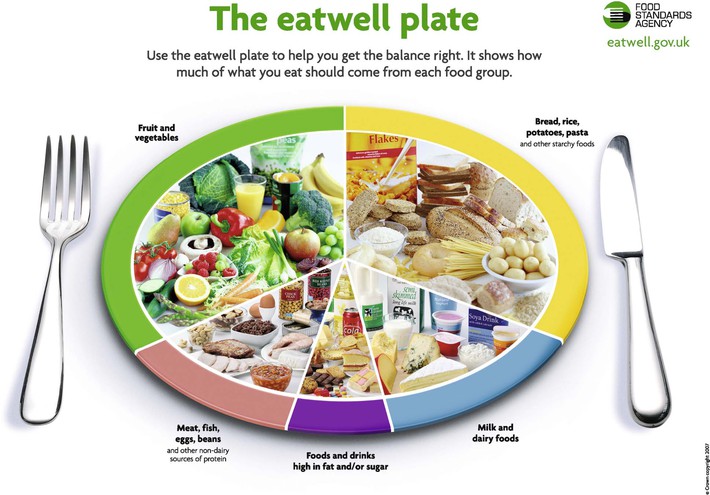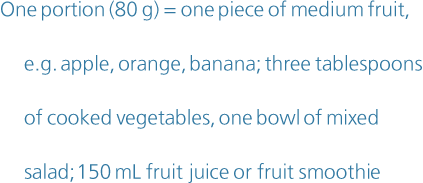Chapter 11
Introduction to nutrition
Many foods contain a combination of nutrients, e.g. potatoes and bread are mainly carbohydrate, but both also contain protein and some vitamins. Fibre, more correctly known as non-starch polysaccharide (NSP), consists of indigestible material. Although it is not a nutrient as it is neither a source of energy nor essential for cellular metabolism, NSP is important in the diet as it has many beneficial effects on the body.
The diet is the selection of foods eaten by an individual. A balanced diet is essential for health and provides appropriate amounts of all nutrients in the correct proportions to meet body requirements. An essential nutrient is a substance that cannot be made by the body and must therefore be eaten in the diet.
The first parts of this chapter explore the balanced diet and its constituents. Nutrition and its impact on older adults is discussed.
Many health problems arise as the result of poor diet. In developed countries obesity is increasingly common, while in other countries malnutrition is widespread; the final section considers some consequences of poor nutrition.
The balanced diet
A balanced diet contains appropriate proportions of all nutrients required for health, which is normally achieved by eating a variety of foods, with the exception of breast milk, this is because no single food contains the correct proportions of the essential nutrients. If any nutrient is eaten in excess, or is deficient, health may be adversely affected. For example, a high-energy diet can lead to obesity, and an iron-deficient one to anaemia.
A balanced diet is important in maintaining a healthy body weight, which can be assessed by calculating body mass index (BMI) (Box 11.1).
Healthy eating, i.e. eating a balanced diet, requires some knowledge and planning. An important dietary consideration is the amount of energy required, which should meet individual requirements. Daily energy requirements depend on several factors including basal metabolic rate (p. 314), age, gender and activity levels. Dietary carbohydrates, fats and proteins are the principal energy sources and fat is the most concentrated form. Dietary energy is correctly expressed in joules or kilojoules (kJ) although the older terms calories and kilocalories (kcal or Cal) are also still used in the UK.
This section is based on the recommendations of the British Nutrition Foundation (2013). Recommendations for daily food intake sort foods of similar origins and nutritional values into food groups, and advise that from the age of two years a certain proportion from each group be eaten daily (Fig. 11.1). If this plan is followed, the resulting dietary intake is likely to be well balanced. The five food groups are:
The first two groups above should form two-thirds of the diet with the other groups forming the remainder with only limited amounts of food and drinks high in fat and/or sugar.

Figure 11.1 The eatwell plate. The main food groups and their recommended proportions within a balanced diet.
Bread, rice, potatoes, pasta
The British Nutrition Foundation recommends that this group should make up one-third of the diet and that each meal should be based around one food from this group. Potatoes, yams, plantains and sweet potato are classified as ‘starchy carbohydrates’ and are, therefore, considered within this group rather than as fruit and vegetables. Other foods in this group include breakfast cereals, rice and noodles. These foods are sources of carbohydrate and fibre that provide sustained energy release. Some also contain iron and B-group vitamins including folic acid (p. 279).
Fruit and vegetables
Foods in this group include fresh, frozen and canned products, 100% fruit or vegetable juices and pure fruit smoothies. These foods provide carbohydrate, fibre, vitamin C, folic acid and fibre. A minimum of five portions per day is recommended.

Milk and dairy foods
Foods in this group provide protein and minerals including calcium and zinc; some are also a source of vitamins A, B2 and B12. They include milk, cheese, fromage frais and yoghurt, and often contain considerable amounts of fat. Intake should therefore be limited to three servings per day.

Meat, fish, eggs, beans
In addition to the food shown in Figure 11.1, this group includes meat products such as bacon, sausages, beefburgers, salami and paté. Moderate amounts are recommended because many have a high fat content. It is suggested that fish, including one portion of oily fish, e.g. salmon, trout, sardines or fresh tuna, is eaten twice weekly. This food group provides protein, iron, vitamins B and D and sometimes minerals. Vegetarian alternatives include tofu, nuts, beans and pulses, e.g. lentils. Beans and pulses are also a good source of fibre.
Foods and drinks high in fat and/or sugar
These foods are illustrated in Figure 11.1 and also include oils, butter, margarine (including low-fat spreads), mayonnaise, fried food including chips, crisps, sweets, chocolate, cream, ice cream, puddings, jam, sugar and soft drinks, but not diet drinks. Fats are classified as saturated or unsaturated and the differences between these are explained on page 277. Foods in this group should only be used sparingly, if at all, as they are high in energy and have little other nutritional value.
Additional recommendations
The British Nutrition Foundation makes other specific recommendations about salt (p. 280) and fluid intake (1.5–2 L per day). This includes water, tea, coffee, squash and fruit juice. Alcohol intake should not exceed 3–4 units per day for men and 2–3 units per day for women.

Groups of people with specific dietary requirements
Certain groups of people require a diet different from the principles outlined above. For example, pregnant and lactating women have higher energy requirements to support the growing baby and milk production. Menstruating women need more iron in their diet than non-menstruating women to compensate for blood loss during menstruation. Babies and growing children have higher energy requirements than adults because they have relatively higher growth and metabolic rates. In some gastrointestinal disorders there is intolerance of certain foods, which restricts dietary choices, e.g. coeliac disease (p. 331).
Digestion, absorption and use of nutrients are explained in Chapter 12. Structures of carbohydrates, proteins and fats are described in Chapter 2.
Nutrients
Carbohydrates
Carbohydrates are mainly sugars and starches, which are found in a wide variety of foods, e.g. sugar, jam, cereals, bread, biscuits, pasta, convenience foods, fruit and vegetables. Chemically, they consist of carbon, hydrogen and oxygen, the hydrogen and oxygen being in the same proportion as in water. Carbohydrates are classified according to the complexity of the chemical substances from which they are formed.
Monosaccharides
Carbohydrates are digested in the alimentary canal and absorbed as monosaccharides. Examples include glucose (see Fig. 2.7, p. 26), fructose and galactose. These are, chemically, the simplest form of carbohydrates.
Disaccharides
These consist of two monosaccharide molecules chemically combined, e.g. sucrose (see Fig. 2.7, p. 26), maltose and lactose.
Polysaccharides
These are complex molecules made up of large numbers of monosaccharides in chemical combination, e.g. starches, glycogen and cellulose.
Not all polysaccharides can be digested by humans; e.g. cellulose and other substances present in vegetables, fruit and some cereals pass through the alimentary canal almost unchanged (see NSP, p. 281).
Functions of digestible carbohydrates
These include:
• providing energy stores when carbohydrate is eaten in excess of the body’s needs as it is converted to:
– glycogen – as a short-term energy store in the liver and skeletal muscles (see p. 315)
– fat, that is stored in adipose tissue, e.g. under the skin.
Proteins (nitrogenous foods)
During digestion proteins are broken down into their constituent amino acids and it is in this form that they are absorbed into the bloodstream. A constant supply of amino acids is needed to build new proteins, e.g. structural proteins, enzymes and some hormones.
Amino acids (see Fig. 2.8)
These are composed of the elements carbon, hydrogen, oxygen and nitrogen. Some contain minerals such as iron, copper, zinc, iodine, sulphur and phosphate. Amino acids are divided into two categories: essential and non-essential.
Essential amino acids cannot be synthesised in the body, therefore they must be included in the diet. Non-essential amino acids are those that can be synthesised in the body. The essential and non-essential amino acids are shown in Box 11.2.
Nitrogen balance
Excess amino acids are broken down. The amino group (~NH2) is converted to the nitrogenous waste product urea and excreted by the kidneys. The remainder of the molecule is converted to either glucose or a ketone body (see ketosis, Ch. 12), depending on the amino acid. Negative nitrogen balance occurs when amino acid supply does not meet body needs. This situation may arise either when dietary protein intake is inadequate, e.g. deficiency or absence of amino acids, or protein requirement is increased, e.g. during growth spurts and following injury or surgery.
Biological value of protein
The nutritional value of a protein, its biological value, is measured by how well it meets the nutritional needs of the body. Protein of high biological value is usually of animal origin, easily digested and contains all essential amino acids in the proportions required by the body.
A balanced diet, containing all the amino acids required, may also be achieved by eating a range of foods containing proteins of lower biological values, provided that deficiencies in amino acid content of any one of the constituent proteins of the diet is supplied by another. A balanced vegetarian diet consists primarily of proteins with lower biological values, e.g. vegetables, cereals and pulses. When proteins from different plant sources are combined, they complement each other providing higher biological values than a single plant source. Through this complementary action the biological value of vegetarian diets can be similar to those based on animal protein.
Functions of proteins
Amino acids are used for:
• growth and repair of body cells and tissues
• synthesis of enzymes, plasma proteins, antibodies (immunoglobulins) and some hormones
Stay updated, free articles. Join our Telegram channel

Full access? Get Clinical Tree



